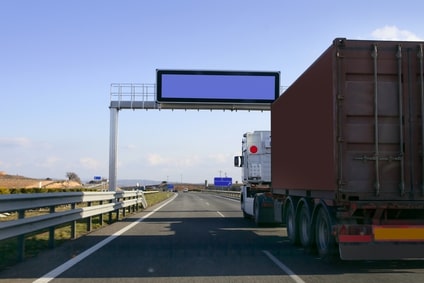Ever since the National Highway Traffic Safety Administration (NHTSA) first formed in 1970, there has been an onslaught of rules and regulations that fleet managers, operators, and truck makers alike have been made to follow. While these regulations vary greatly, both in terms of seriousness and complexity, the two that are most often confused are none other than GVWR and GCWR.
Although their acronyms may be similar, GVWR and GCWR are separate systems that work, both together and independently, to help determine the full weight of a vehicle and/or its trailer. Let’s see how these differ by first taking a look at the definitions of GVWR and GCWR:

GVWR stands for gross vehicle weight rating; it is the very measurement that is attached to most commercial vehicles, from lightweight pickups to the largest 18-wheelers allowed on roadways.
Put simply, GVWR is designed to take into account the total weight of the vehicle, measured by: 1) the base curb weight of the vehicle and 2) the weight of optional accessories, cargo, and the operator/passengers. Depending upon the manufacturing process of the vehicle, the GVWR might change over time (more on this later).
GCWR stands for gross combination weight rating; it is usually determined by the manufacturers of the chassis, based on the corresponding SAE International guidelines. A vehicle’s GCWR is the maximum allowable combined mass of a road vehicle, the passengers and cargo in the tow vehicle, plus the mass of the trailer and cargo in the trailer. It’s determined by adding the GVWR of the power unit (the truck) to the GVWR of the trailer.
Mainly, the GCWR is used in vehicle testing to determine a range of safety trials, most notably, the braking capabilities for the towing vehicle chassis braking system.
Both GVWR and GCWR deal with weight, as you can see by the explanations above, but the ratings determine two different aspects. GVWR is the total weight of the truck (payload included), while GCWR is a specialized weight rating that can only be established by the manufacturer of the chassis.
These days, the ratings are particularly important to calculate correctly, especially for established operations who are used to using GVWR and GAWR (gross axle weight rating), interchangeably. While this method might have been an easy shortcut years ago, advancement of system standards and emerging automation elements have altered the common front and rear axle weights significantly.
It’s an important factor to assess, as it shows just how different GVWR and GCWR are from one another, as well as the other various similar-sounding weight ratings, like GAWR.

In addition to designing and constructing vehicles, truck makers also must consider how factors like GVWR and GCWR affect operating requirements for towing, a factor that can have bearing on sales, marketing, and, of course, safety.
According to the Association for the Work Truck Industry, most commonly known as the NTEA, SAE International Guidelines dictate that the commercial work trucks rigged to tow a trailer come with a long list of requirements that must be followed by the operating company, as well as the operator. Here is the main protocol that must be followed in order for the rig to be fully-compliant. In these cases, operators must possess a CDL if:
As the NTEA states, “if a trailer has a GVWR of 11,500 pounds and is towed by a truck with a GVWR of 15,000 pounds, resulting in a GCWR of 26,500 pounds, then the operator must have a CDL.”
On the other hand, if these combined weights do not exceed 26,000 pounds, then the operator is not required to hold a CDL. The tricky thing here, though, is that the loads placed onto the truck and its trailer are still considered part of the final weight, an important consideration for truck makers who may be on the fringe of tipping the scale, but are marketing to individuals or firms that run more lightweight fleets.
The NTEA warns that some final-stage truck manufacturers, the companies that are the very last ones to alter a vehicle before a sale, are hesitant to make any changes to the original manufacturer’s GVWR, even when modifications have been made the affect the overall weight. While some operations may manage to get away with leaving the original GVWR figure on the VIN placard, the shifts in weight must be noted.
While the final GVWR does, in fact, fall on the shoulders of the final-stage truck manufacturer, not all have the internal tools they need to confirm this figure. Because of this, the NTEA suggests that there exists “sufficient testing, engineering analysis and certification documentation to ensure ongoing compliance.”
The difference between GVWR and GCWR may be slight for certain vehicles, but, for manufacturers of heavy trucks, their differences are actually rather impactful ones. Take the time to get to know the distinctions and always let them guide your designs, as well as the communication with your customers.
All trucks should have a properly displayed, durable transportation plate to clearly display these ratings and other information paramount for operating the vehicle safely. These plates are typically displayed on or near the driver’s door and should be durable enough to remain readable throughout the lifespan of the vehicle. Properly displayed, readable nameplates help to ensure compliance and aid manufacturers and operators in ensuring safe fleet operation.
Our sales engineers are experts in automatic asset tracking, tagging and identification,a nd can answer all your questions. Get in touch now.
Lets Talk ›